The intricacies of repairing Samsung vacuum cleaners

Today the vacuum cleaner has become a common device, it is available in every home and greatly facilitates the work of the owners. Many companies are engaged in the production of vacuum cleaners; they offer various products with a wide price range. Vacuum cleaners of the Samsung brand are very popular among consumers, as they have a reliable assembly and a long service life, but, like any equipment, they also fail over time. But a breakdown is not yet a reason to contact a service center, especially when the warranty period has expired, and you will have to pay for the work of the master. And even more so, there is no need to rush to buy a new device. If you follow the recommendations of experts exactly, then you can repair the vacuum cleaner yourself, at home.
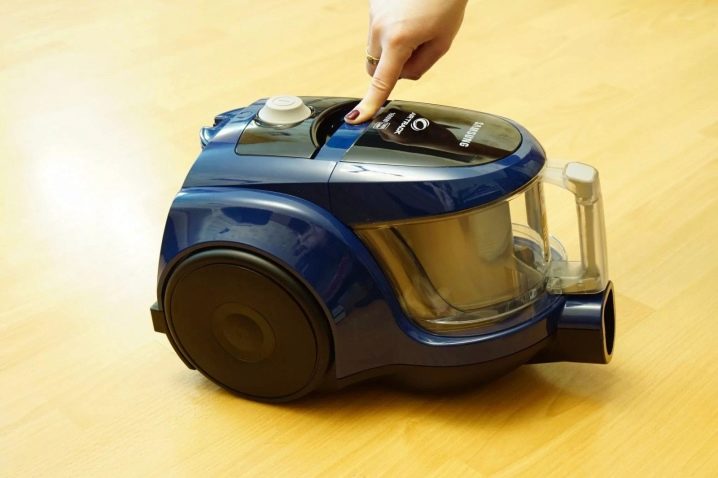
Device of various models
The Korean corporation Samsung occupies one of the first places in the world for the production of all kinds of harvesting equipment. It manufactures all types of vacuum cleaners: industrial, construction, for cleaning companies, but the most popular are household appliances for home use. These devices also come in many varieties, for example, for dry or wet cleaning, washing vacuum cleaners, units with an aquafilter, and even robotic vacuum cleaners.
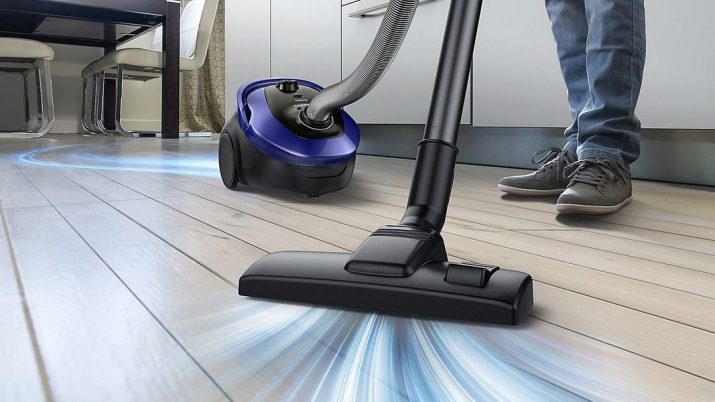




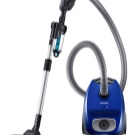
Each type of product has its own functionality and technological features, on which the type of breakdown and the complexity of the repair may depend. Let's consider the most common models of Samsung household vacuum cleaners and their technical characteristics.
Samsung SC4520
A budget version of vacuum cleaners from the popular Air Track series (literal translation - "airway"), where a special plastic container is used instead of a garbage bag. For its price, it has a fairly good suction power - 350 W, and a power consumption of 1600 W. There is no suction power adjustment. Provides dry cleaning only. Equipped with a cyclone filter and a double (two-chamber) container that separates coarse and small debris. The volume of the dust collector is 1.3 l, the weight of the vacuum cleaner is 4.3 kg. Power cord length - 6 m, automatic rewinding.

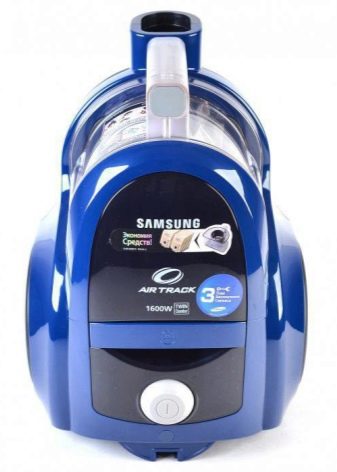
Samsung Easy1500
The full model name is SC52-EO. Household vacuum cleaner with average suction power - up to 370 W, and power consumption of 1500 W. The device is equipped with a cloth bag for collecting debris and an additional filter installed in front of the engine impeller. The volume of the dust container is 2.5 liters. Cord length is 6 meters, automatic rewinding system. The weight of the device is 3.7 kg. Provides only dry cleaning: if moisture gets in, the engine can quickly fail. Emits an average noise level - up to 85 decibels. Has a dust collector full indicator and a power regulator.


Samsung VC-5853
An inexpensive medium power option, great for cleaning small spaces. Equipped with a 2.4 liter garbage bag, for dry cleaning only. The power consumption of this Samsung vacuum cleaner is 1300W, the suction power is 330W. Equipped with a built-in fill indicator. The length of the electric cable is 6 meters, the type of winding is automatic, the permissible radius of action is 8.5 meters. The device weighs 3.6 kg. Has an additional fine filter.The generated noise level does not exceed 78 decibels. The suction tube is split and can be disassembled into three parts.

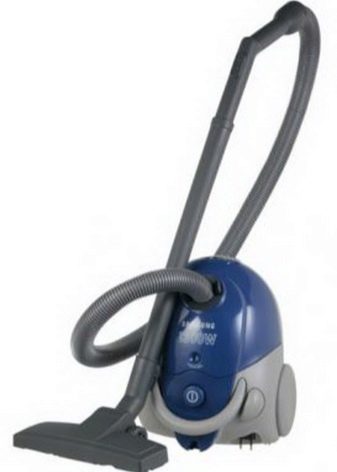
Samsung SC6570
A modern household vacuum cleaner without a bag for collecting dust. In it, debris accumulates in a special 1.4 liter plastic cyclone filter. It has a dust collector full indicator and a convenient telescopic tube on which the power regulator is located. The weight of the device is 5.3 kg. The length of the electric cable is 6 meters, the range of the vacuum cleaner is up to 9 meters. Suction power - 380 W, power consumption - 1800 W. The noise level is no more than 78 dB. It is completed with an additional turbo brush and a fine filter. Assumes only dry cleaning, moisture ingress into the dust collector is highly undesirable.
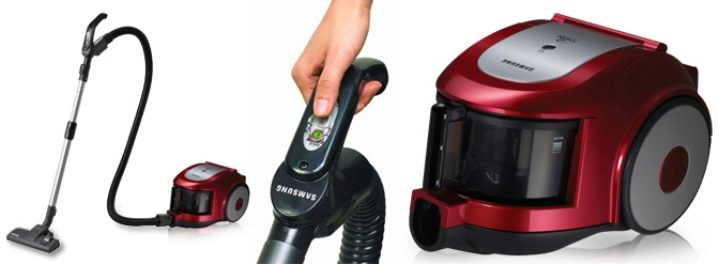
Samsung SC6573
Compact and handy household vacuum cleaner with a plastic dust collector (cyclone filter). Equipped with a telescopic sliding tube and a container full indicator. A power control mechanism is built into the tube handle. The device weighs 5.2 kg, the volume of the dust collector is 1.5 liters. The power consumption is 1800 watts and the suction power is 380 watts. The level of noise generated during operation is 80 decibels. The cable retraction type is automatic, the cable length is 6.1 meters, and the range of the vacuum cleaner is 9.2 meters. The kit includes a turbo brush. The vacuum cleaner is intended for dry cleaning.

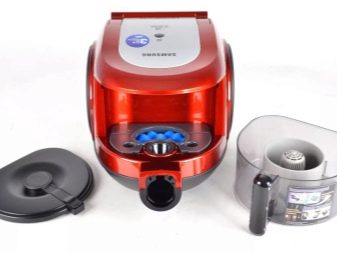
Samsung SW17H9090H
A versatile vacuum cleaner with an unusual and stylish design that performs both dry and wet cleaning. Dust collector type - 2 liter aqua filter. The kit includes an additional HEPA filter and a turbo brush. Extendable suction tube with built-in power regulator. The weight of the device is 8.9 kg. The length of the network cable is 7 meters, the type of reeling is automatic. The radius of the vacuum cleaner is 10 meters. Power consumption - 1700 W, suction power - 250 W.

When choosing a model and during operation of the device, it is imperative to take into account the manufacturer's recommendations regarding the type of cleaning to be performed. Many owners believe that if the vacuum cleaner has a plastic dust container (container), then regardless of the model, it can be used to remove spilled liquids or during wet cleaning of carpets.
This opinion is wrong. The plastic container itself is not exposed to moisture, and it can even be washed under the tap, after removing it from the device... But if the vacuum cleaner is not intended for wet cleaning, then its filters do not retain moisture, and it, even in small quantities, will certainly get into the engine of the device. Subsequently, this can lead not only to the failure of the unit itself, but also to a short circuit of the electrical wiring in the room.


Common malfunctions
The type and severity of the breakdown may to some extent depend on the model of the device. But since, in general, the device of all Samsung vacuum cleaners has a rather simple design, then the types of breakdowns are usually the same. Troubleshooting work in different models practically does not differ from each other. The main difference in repair is the configuration or type of the replaced part, depending on the purpose and capabilities of the vacuum cleaner. Each model may also assume different actions when disassembling the case or engine, but in general, the procedure is not complicated.


Before proceeding with disassembly, it is necessary to conduct a thorough diagnosis, and try to establish the nature of the malfunction as accurately as possible. This saves you unnecessary steps and saves time. An overfilled container, a clogged hose or tube is often the cause of reduced performance. Each type of breakdown or malfunction has its own symptoms, which are the same for all models of Samsung household vacuum cleaners. Let's take a closer look at all the signs that the device needs repair or maintenance.
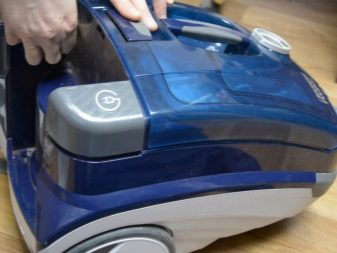

Does not turn on
When, after pressing the power button, the vacuum cleaner motor does not start, it means that there are problems with the electrical part. First you need to make sure that the outlet itself is in good condition - connect other household appliances to it. If the outlet works, you can start diagnosing the vacuum cleaner. First of all, you should carefully inspect the cord of the device for kinks, cracks, abrasions. It happens that visually the cord looks intact, and damage can be detected only by feeling the cable with your hands along its entire length - the break will be soft. Then you just need to cut the cord in this place, connect the broken cable and wrap the twist with electrical tape.


The cable can also burn out, and it will not be possible to establish this by probing with your hands. An electrical tester will help here. It is necessary to disassemble the plug of the vacuum cleaner and "ring out" the wires. It is quite difficult to visually find the place of burnout - if the darkened areas are not visible, then a complete replacement of the entire cord will be required. Failure of the power button itself is possible, for example, the circuit board for switching the speed of revolutions or its other elements. Then you need to disassemble the body of the vacuum cleaner, dismantle the mechanism for switching on and adjusting the power, and connect the cable directly.
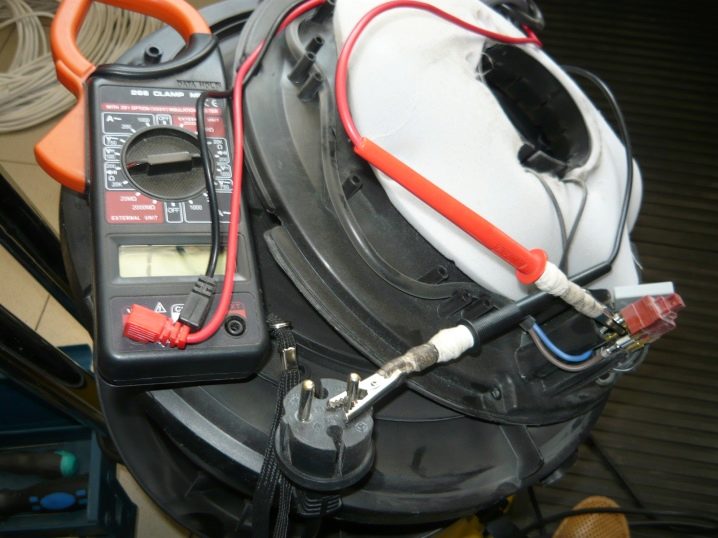
If this manipulation did not give results, it means that the engine is out of order or its brushes are worn out.
Pulls poorly
The most common cause of poor traction is a blockage in the device tube or hose. It is necessary to disconnect the hose from the vacuum cleaner and remove the metal pipe from it. View these elements by light, if a blockage is found, remove it with a wire or other similar object. For convenience, the hose can be laid flat on the floor or pulled out by hand. If the tube is collapsible, disconnect all components, including the brush. The telescopic tube must be pushed inward as far as it will go.
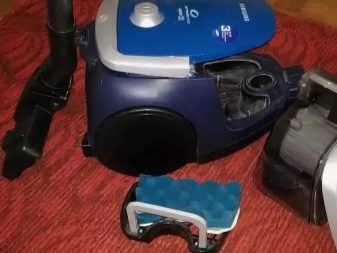

Often, blockages are formed in the design of the brush itself, it is difficult to find them there, since the brush has a curved shape. In this case, you need to disassemble it by unscrewing the mounting screws, inspect and clean the inside. Particular attention should be paid to turbo brushes - they quickly clog up, winding hair and threads around themselves, which then clings to small debris. To clean them, you need to unscrew the plastic fixing screw from the end of the brush, remove and clean the inner rod.
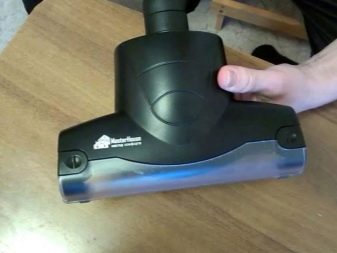

Poor traction can also be caused by hose breakage - the formation of cracks. This happens when housewives are too lazy to bend over to carry the vacuum cleaner, and they pull it by the tube, dragging it around the room. If such cracks form, a complete hose replacement will be required. You can wrap the breaks with duct tape or stick a soft rubber patch on them, but this will only be a temporary solution, as the crack will grow larger over time.


Often the cause of poor draft is a banal clogging of the filter or an overfilled dust container. It is necessary to clean the dust container (the cloth bag can even be washed), thoroughly clean or replace the removable filters if cleaning is no longer possible due to their long service life. If, after all the procedures done, the thrust does not improve, then there are problems with the engine of the device - its speed has dropped. It is necessary to dismantle the unit and identify the cause.

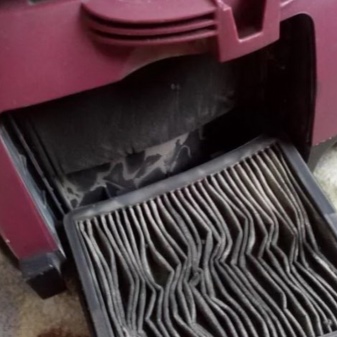
Noises and vibrates
The cause of extraneous noise in vacuum cleaners with a plastic dust collector is often a large object that has fallen into the container: a metal nut, a bead, a button. Therefore, the first thing to do is to clean the dust container, check it for internal damage (chips, breakdowns, cracks). In vacuum cleaners with a garbage bag, the same foreign object may be noisy, inside the case outside the bag. You need to open the lid, remove the bag and carefully examine the inside of the device. However, there are more serious causes of noise.
- Damage to the fan or its seats in vertical vacuum cleaners.It is necessary to disassemble the case, try to balance, lubricate or replace the fan, depending on its condition.
- In washing models, extraneous noise can be caused by an exhausted pump, which pumps water into the hose - only its complete replacement will help here.
- Unnatural noise and rattling can occur due to broken bearings in the brush of the device. Then it is necessary to unscrew the end cap and take out the working shaft. Clamping one end of it with pliers, unscrew the end mounting bolt, inspect and, if necessary, replace the components: bearings, anthers, seals, gaskets.
- In some models, the working shaft in the brush is fixed with a special belt. When the belt wears out or breaks, the shaft inside the structure begins to beat against the housing. It is necessary to disassemble the brush, try to tighten or replace the belt.


In most cases, the vacuum cleaner vibrates and hums unnaturally due to engine malfunctions. The reason may be a broken seat for the shell of the electric motor. Then the repair will be relatively simple - you can wrap electrical tape around the metal shell so that it adheres more tightly to the body of the vacuum cleaner. But most often, the reason for excessive vibration is the development of the constituent elements of the engine: an anchor, a stator or their fixation points. To eliminate such a problem, it will be necessary to replace the exhausted element, or even better, the entire engine.
Required tools
The tools you need will depend on the type and model of your Samsung vacuum cleaner. When disassembling and repairing, preventing or cleaning the device, as well as its individual elements, you cannot do without the following devices:
- Phillips and slotted screwdrivers - their sizes are selected in accordance with the type and depth of the screws;
- pliers;
- clerical, or better professional construction knife;
- lubricant;
- electrical insulating tape;
- electrical tester.
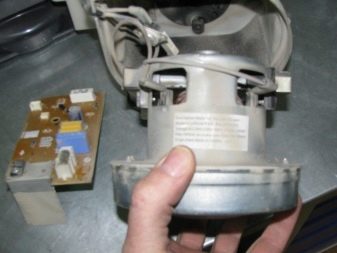

In many ways, the type of work performed will also influence the choice of tools. For example, sandpaper and a degreasing agent (acetone, solvent) will be needed to clean the surface of the suction hose before gluing the cracks. It is convenient to remove dirt on the brush shaft of the vacuum cleaner with scissors, and to remove blockages you will have to use a long hard wire. For bonding cracks or chips on the case, a universal super glue is suitable, while moving parts such as a hose require a more flexible adhesive.


How to disassemble the case correctly?
For the convenience of work, you first need to remove the plug from the socket and disconnect the suction hose from the vacuum cleaner, otherwise it will interfere with disassembly. Then it is necessary to remove the plastic dust container or garbage bag, as well as dismantle all filters. Using a suitable screwdriver, remove all fixing screws. As a rule, they are located on the outside: two in the front of the vacuum cleaner and four on the other side (under the handle and at the end). The location and number of screws depends solely on the model and type of appliance.

In most models of Samsung vacuum cleaners, in addition to external screws, there are also internal ones, they can be located under the cassette container, in the front part just under the lid or near the suction opening in front of the engine impeller.
In Samsung vacuum cleaners, the fastening screws with which the body is assembled are not masked. They are not difficult to find, you just need to carefully examine the entire apparatus. But it should also be taken into account that, in addition to screws, individual parts of the device case can be attached to each other using special plastic latches. Therefore, if, after unscrewing the screws, the case does not disassemble, you should not be zealous and use force, otherwise it is easy to break it.

It should be disassembled very carefully: pry off the upper part (preferably in the front part) with a construction or clerical knife, and remove it from the structure of the vacuum cleaner with a smooth, upward movement.If the lid is also secured with plastic locks, then in these places it will not give in - you will need to pry all the latches one by one. It is convenient to do this with a flat metal object: a ruler, a knife. It is not recommended to use a slotted screwdriver as it can damage the case.
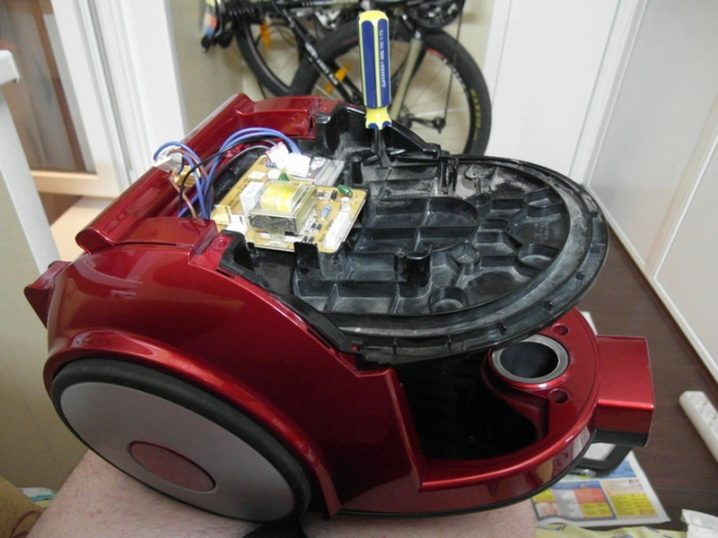
Dismantling the engine
The electric motor, like the outer cover, is attached to the body of the vacuum cleaner with screws. They are all located at the top. Before dismantling the unit, carefully disconnect the wires going from it to the board for switching on the vacuum cleaner and switching speeds. Then unscrew the screws and dismantle the metal shell, in which the motor of the device is placed. After that, you need to remove the rubber O-ring located in the lower part - it is usually bolted. The metal shell consists of two halves, you can separate them with a slotted screwdriver: insert its end into the slot and carefully separate the parts, going around the slot along the perimeter.
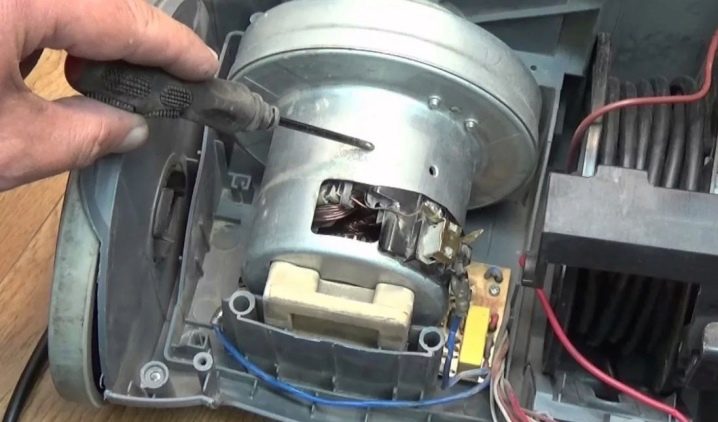
Inside the metal shell, the engine elements can be placed in a plastic container, it also consists of two halves and can be disassembled with a slotted screwdriver.
Engine repair will depend on the type of failure. If the brushes are out of order, that is, they are worn out, they will need to be replaced. It will be necessary to unscrew the screws that secure the landing boxes of the brushes, and dismantle the latter. Having purchased similar new parts from the store, install them in place in the same way. A frequent breakdown of the engine is the failure of the armature or stator. In the anchor, a part of the lamellas usually burns out, due to which the engine speed decreases and the thrust deteriorates. In the stator, the winding burns out. Both parts can be replaced with new ones by purchasing analogs in the store. Some models of Samsung vacuum cleaners do not provide for disassembly and repair of the motor - the unit is placed in a solid rolled metal case. In these cases, only a complete replacement of the entire engine is possible.

Removal of contamination
The choice of method for removing contamination depends on the specific part or element of the vacuum cleaner to be cleaned. The body - both outside and inside, can be cleaned with a damp cloth. It is convenient to clean its parts and all kinds of recesses with a soft brush or a brush. The plastic container, hose, pipe are washed under running water using a soap solution. The garbage bag can be washed by hand or in the washing machine, and additional felt filters can also be washed.

As for special fine filters (HEPA filters), there are several types, each of which involves different cleaning methods. Only HEPA filters with the letter W in the product label can be washed under running water, this should also be mentioned in the instructions for the vacuum cleaner. Such filters are washed only under cold running water without the use of soap solutions and cleaning agents, household chemicals. Then let it dry at room temperature, in no case should you dry the filter on a radiator, fireplace or near a gas stove.

Other types of HEPA filters cannot be washed - they are cleaned with a brush or blown with air, otherwise the product completely loses its capabilities, deforms. The service life of HEPA filters is 1-2 years, depending on the frequency of use of the vacuum cleaner. Disposable filters are made from paper and fiberglass. They do not provide for any cleaning at all, even blowing with air will destroy the structure of the product. Therefore, when the disposable filter becomes clogged, it is simply replaced with a new one.

Preventive measures
Preventive measures include regular inspection and replacement of filters, timely cleaning of the container or garbage bag, and removal of contaminants inside the corrugated hose and tubing. It is also recommended to periodically wipe dust from the inner and outer surfaces of the vacuum cleaner body. Brushes also require regular cleaning, especially turbocharged ones.

How to repair a Samsung vacuum cleaner, see the following video.











The comment was sent successfully.